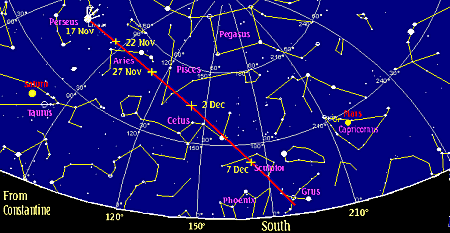| The
Linear C/2000 WM1 comet has been brightening more and more, although
not to the point of becoming a naked eye object. It is now a 5.2 magnitude
fuzzy spot in the constellation of Cetus, an easy target forbinoculars.
A star chart may be useful to spot it during its peregrinations through
the low magnitude star field of the Pisces, Cetus, Sculptor region.
The SIRIUS observers team has been spotting and following the Comet
for quite some time and feel it is a nice binocular project for experienced
amateurs.(See the picture at left for an early view of Linear. It's
the nebulosity at the center).
Discovered on December 16, 2000 at the Lincoln Near-Earth Asteroid
Research center (LINEAR) with their automated 1m telescope when at magnitude
18. It will reach its perihelion (Closest distance to the Sun) on January
22, 2002 when it will pass at 0.55 UA from the Sun, while its closest
approach to Earth is these days when it is passing to within 0.3 UA
from Earth.
It is now an evening object which stay up till late at night. It has
become a conspicuous object only lately, and might even become visible
if it brightens suddenly when approaching the Sun, although the hope
of such a happening, high few months ago, has now waned. With the Moon
rising late those early December days, that's the time to catch a glimpse
of a fine comet in time where bright comets are scanty.
|
Orbital
Elements for Comet Linear C/2000 WM1 |
| Epoch
|
2001 Oct.18.0TT |
| Perihelion
date, T |
2002 Jan22.6837TT |
| Perihelion
distance, q |
0.555391 a.u. |
| Argument
of perihelion |
1.000267 |
|
Excentricity, e |
276.7703° |
| Long.
of ascend. node |
237.8971° |
| Inclination,
i |
72.5508° |
|
.gif) |
For those who
possess a good Planetarium like program (Skymap,...), here's the
comet's coordinates to have it included among the displayed objects
(Source: Minor Planet Circular 43018).
Indeed a nice comet. Members of
our association could follow for some two weeks it till December
7th with binoculars. It was in particular observed vividly December
5 in the Cetus Constellation while the weather was particularly
good, between Phi3 ceti and TYC 5272-1142-1. The tail could be
resolved with a 10x50 binoculars albeit with difficulty. |
|
